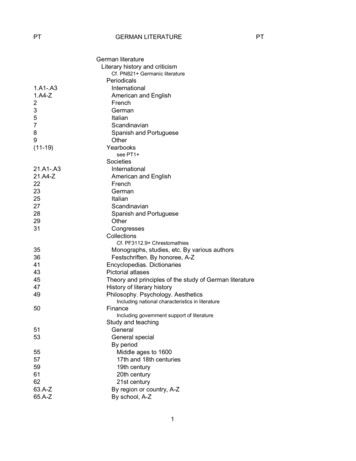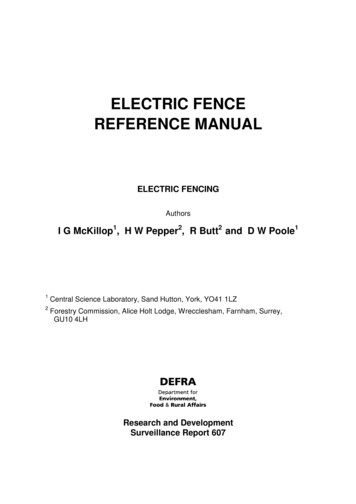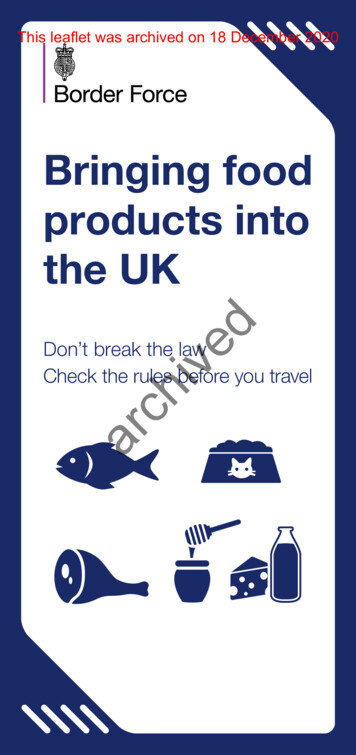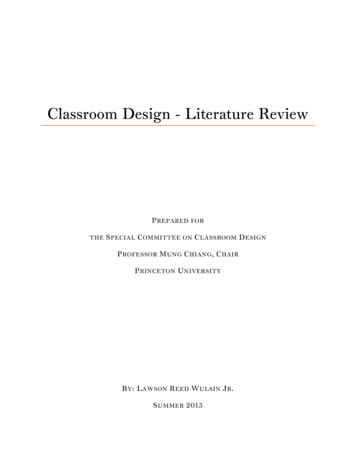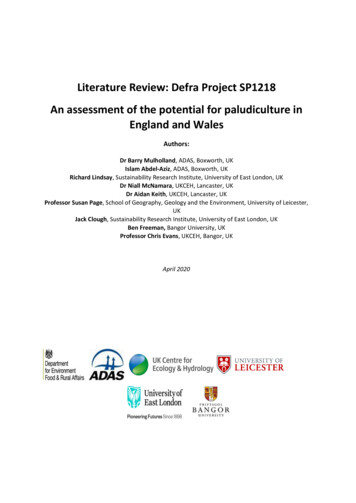
Transcription
Literature Review: Defra Project SP1218An assessment of the potential for paludiculture inEngland and WalesAuthors:Dr Barry Mulholland, ADAS, Boxworth, UKIslam Abdel-Aziz, ADAS, Boxworth, UKRichard Lindsay, Sustainability Research Institute, University of East London, UKDr Niall McNamara, UKCEH, Lancaster, UKDr Aidan Keith, UKCEH, Lancaster, UKProfessor Susan Page, School of Geography, Geology and the Environment, University of Leicester,UKJack Clough, Sustainability Research Institute, University of East London, UKBen Freeman, Bangor University, UKProfessor Chris Evans, UKCEH, Bangor, UKApril 2020
ContentsEXECUTIVE SUMMARY . 51 INTRODUCTION . 81.1 History of Peatland Agriculture in the United Kingdom . 81.2 Extent and Status of Lowland Peatlands in the United Kingdom . 91.3 Peatland Rewetting . 101.4 Paludiculture. 112 PRODUCTIVITY AND SUITABILITY OF LAND FOR PALUDICULTURE . 132.1 Wetland Productivity . 132.2 Wetland Plants . 142.3 Land Suitability for Paludiculture . 153 OPTIONS FOR PALUDICULTURE. 183.1 Paludiculture and the Growing Media Industry . 183.1.1 Peat Extraction & Consumption in the UK . 183.1.2 Sphagnum Farming as a Growing Media Constituent . 203.1.2.1 Sphagnum Farming in Germany . 203.1.2.2 Sphagnum Farming in the UK . 213.1.2.3 Practical Challenges for Sphagnum Farming . 223.1.2.4 Economic Considerations . 233.2 Paludiculture for Bioenergy . 253.2.1 Potential Bioenergy Crops from Paludiculture . 253.2.1.1 Suitability of Tree Species within a Paludiculture Context . 253.2.1.2 Potential of Non-Tree Species in a Paludiculture Context . 263.2.2 Characteristics of Key Crops . 273.2.2.1 Phragmites australis (Common Reed) . 273.2.2.2 Typha latifolia (Cattail/Bulrush/Reedmace) . 293.2.2.3 Miscanthus x giganteus. 303.2.3 Paludiculture and Solar Power . 323.3 Paludiculture for Food Production. 323.3.1 Wetland Crops. 323.3.2 Litter, Fodder and Grazing . 333.3.3 Fisheries . 353.4 Other Potential Paludiculture Products. 353.4.1 Alternative Uses for Sphagnum . 353.4.2 Other Medicinal Crops . 363.4.3 Use of Paludiculture Crops in Construction Materials . 362
3.4.3.1 Traditional Uses. 363.4.3.2 Novel Uses . 373.4.4 Use of Paludiculture Crops in Fabrics. 384 GHG EMISSIONS/REMOVALS AND ASSOCIATED IMPACTS OF PALUDICULTURE . 404.1 Estimation of Direct GHG Emissions and Removals . 404.1.1 Carbon Dioxide and Methane . 404.1.1.1 Emissions Calculator. 434.1.2 Nitrous Oxide . 444.2 Indirect GHG Emissions and Removals . 454.2.1 GHG Mitigation Potential of Bioenergy . 454.2.1.1 Biomass Data . 464.2.1.2 Harvesting Machinery and Diesel Consumption . 464.2.1.3 Transport and Processing . 464.2.1.4 Conversion Efficiencies and Realised Energy Yields. 474.2.1.5 Potential CO2 Savings . 484.3 Peat Subsidence. 484.3.1 Subsidence Calculator . 494.4 Water and Energy Use . 504.4.1 Water Fluxes under Conventional and Paludiculture Management . 504.4.2 Energy use and Associated GHG Emissions due to Pumping . 524.4.3 Energy use and Associated GHG Emissions due to Surface Irrigation . 534.4.4 Practical Considerations for Water Management . 545 POTENTIAL CO-BENEFITS OF PALUDICULTURE . 555.1 Ecosystem Service Benefits . 555.1.1 Direct Biodiversity Benefits from Paludiculture . 605.1.2 Indirect Biodiversity Gains from Paludiculture . 625.1.3 Flood Risk . 646 BARRIERS AND INCENTIVES FOR PALUDICULTURE . 666.1 Barriers to Transition. 666.1.1 Water Management . 666.1.2 Weed Control . 676.1.3 Mechanisation and Scale . 676.1.4 Trafficability . 686.1.5 Crop Substitution . 686.2 Incentives for Transition . 697 POTENTIAL IMPACTS OF CLIMATE CHANGE ON PALUDICULTURE . 707.1 Climate change threats to paludiculture . 703
7.2 Climate change threats to conventional peatland agriculture . 717.3 Potential opportunities for, and benefits of, paludiculture under climate change . 728 CONCLUSIONS . 72Acknowledgements . 74References. 74Appendix I Plant Species with ‘energy’ in ‘main use categories’ in the UK Paludiculture Live List. . 91Appendix II Literature Identified on Selected Taxa, Including Available Data . 93Appendix III GIS Desk Study Approach to Mapping Potential Paludiculture Areas in Cumbria. . 95Appendix IV Abridged Version of Current UK Paludiculture Live List . 97Please cite as:Mulholland, B., Abdel-Aziz, I., Lindsay, R., McNamara, N., Keith, A., Page, S., Clough, J.,Freeman, B., Evans C. (2020). An assessment of the potential for paludiculture in Englandand Wales. Report to Defra for Project SP1218, 98 pp.4
EXECUTIVE SUMMARYIn England, there are approximately 325,000 ha of lowland peatlands, with 240,000 ha (74% of thetotal stock) used for farming and food production. Much of this has been drained to maximise yieldsof high value fresh produce crops. Sixty nine percent of the cropped peatlands in England are inregular use for horticulture crop production, with the remainder being used for arable/cerealrotation. Peat wastage under cropland is typically 10 to 30 mm yr-1, and this land has the highestgreenhouse gas (GHG) emissions of any UK land-use on peat ( 10 times higher than emissions fromupland peat).As a consequence of these issues, there is a growing interest in ameliorating peat and associated CO2loss through ‘paludiculture’ – namely farming and agroforestry systems designed to generate acommercial crop from wetland conditions using species that are typical of (or tolerant of) wetlandhabitats. The prospect of raising water levels to reduce emissions in peatlands managed forproduction, demands new ways of growing existing crops, or new crops capable of thriving whensubject to the elevated water tables. Where trials have been undertaken, findings suggest thatpaludiculture has the potential to reduce CO2 (and overall GHG) emissions relative to conventionaldrainage-based agriculture or peat extraction. This mitigation potential largely takes the form ofavoided present-day CO2 emissions from deep-drained peat cropland, which can be as high as 25-30tonnes CO2 equivalent per hectare per year. A number of studies, however, suggest thatpaludiculture sites could become net CO2 sinks, thereby helping to remove GHGs from theatmosphere. Sequestering CO2 by adoption and uptake of paludiculture techniques has the potentialto make an important contribution to achieving the UK’s commitment to net zero GHG emissions by2050.Wide scale production of paludiculture bioenergy crops, such as Phragmites australis (CommonReed) can sequester in the region of 4–13 tCO2e ha-1 y-1. As these crops will be used to produceenergy, sequestered CO2 will be re-emitted, resulting (if all sequestered CO2 is removed from the siteas biomass) in a neutral carbon balance at the stand scale. If the bioenergy crops produced substitutefor fossil fuel use, the net CO2 balance, however, will be negative. Other uses of harvested biomass,including incorporation into building materials or the return of biomass carbon to the soil inunreactive forms, have the potential to contribute directly to long-term CO2 sequestration.The majority of peat used in horticulture consists of decomposed Sphagnum moss. One proposedform of paludiculture is the production of Sphagnum crops which can be harvested and processed tocreate growing media. Sphagnum grown at high water tables (e.g. on former peat extraction sites)could be potentially utilised in blended growing media products. Significant research anddevelopment will be required however, before Sphagnum can be considered viable for containerisedplant raising. There is also a need to demonstrate economic viability, since alternative processedmedia must be offered at a comparable and affordable price point, assuming a product can fulfil therequired physical, chemical and biological requirements for containerised production.5
Paludiculture is a land-use focused on farming and agroforestry as the primary activity, andbiodiversity benefits therefore arise as an ‘added-value’ of the activity. Rewetting of lowland peatfor paludiculture could nevertheless generate a number of co-benefits for the environment, wildlifeand human wellbeing. Although likely to be less than those that could be achieved through fullpeatland restoration, the combination of direct financial returns from crop production, climatechange mitigation and biodiversity benefits could help to make paludiculture economically viableprovided that appropriate financial mechanisms are put in place which recognise these broadersocietal benefits.There remain significant practical, economic and societal challenges for the large-scaleimplementation of paludiculture, including the need to support rural economies, maintain nationalfood security, develop markets and supply chains, manage water within complex and heavilymodified landscapes, and avoid displacement of emissions associated with food production to otherareas. Facilitating the wider adoption of paludiculture is likely to require the development of financialincentive schemes for farmers, landowners and investors, new regulatory approaches andinvestment in supporting infrastructure. This is turn requires a stronger evidence base, both todevelop viable paludiculture systems and to accurately quantify the associated benefits and tradeoffs. Compared to conventional crops grown under higher water tables, paludiculture crops mayoffer lower but more reliable economic yields, and by protecting the soil from ongoing loss may helpto maintain the productive lifetime of the and. The high water demand of paludiculture cropspresents some challenges in water-scarce regions, but well-deisigned areas of paludiculture withinfarmed landscapes could also provide effective water storage within the landscape, holding floodwater during winter and releasing some of this to adjacent farmland during summer. Theincorporation of paludiculture areas within farmed landscapes may therefore enhance their overallresilience to climate change.As yet, paludiculture does not offer a comprehensive economic, large-scale, immediatelyimplementable solution to the challenge of high GHG emissions from cultivated lowland peats, andother forms of emissions mitigation such as high water level management of conventionalagricultural land are likely to be needed. However, with further development of crops, watermanagement systems and markets, paludiculture has the potential to become to make a valuablecontribution to the development of more sustainable and resilient peatland farming systems infuture, and to contribute to delivering the UK’s net zero emissions target.6
7
1 INTRODUCTIONThis chapter considers the importance and extent of peatland agriculture in the United Kingdom andintroduces seasonal/continuous rewetting of peat soils as an alternative production practice informer wetlands. Section 1.1 contextualises the drainage of lowland peat soils, Section 1.2 highlightsthe agricultural importance of peatlands, and explores their condition and extent, Section 1.3considers the act of rewetting and its potential to limit GHG emissions, and Section 1.4 introducespaludiculture as a productive use of cropland, under high water table conditions.1.1 History of Peatland Agriculture in the United KingdomMore than two millennia of wetland drainage and conversion to other habitats have resulted in thewidespread loss of wetlands throughout the global terrestrial and coastal environment (Davidson,2014). The driving force behind much of this conversion, at least in the west, has been the conceptof agriculture as an essentially ‘dryland’ activity. This is because a large proportion of crop speciesthat underpin western agriculture have their origins in the semi-desert regions of the Middle East;which included grass species such as, emmer wheat (Triticum dicoccoides), einkorn wheat (Triticummonococcum) and barley (Hordeum vulgare) (Skoglund et al., 2012; Yavas, Unay and Aydin, 2012;Sheenan, 2018; Shiono et al., 2019).Consequently, even while agricultural practices until the modern post-war period were giving rise toincreased biodiversity associated with open ground habitats, wetland biodiversity was decliningbecause wetlands were seen as a hindrance to productive farming. Huge tracts of land in thelowlands were drained by investors seeking to convert land that was agriculturally low-value in theconventional sense into highly profitable farmland – perhaps the most well-known example of thisbeing the draining of the East Anglian Fenland in the 17th-century (Darby, 1940; Darby, 1956; Sheailand Wells, 1983). However, the most extreme of these occurred during WW2, in which the WarAgricultural Executive Committees catalogued every aspect of all farms with a view to maximisingfood production (Darby, 1956; Humphries and Hopwood, 1999).The results achieved by wetland drainage have undoubtedly been extraordinary. The UK’s cultivatedlowland peatlands contribute substantially to regional and national economic output, food securityand livelihoods. The Fens of East Anglia now provide around 50% of all ALC Grade 1 agricultural landin England, they supply 33% of England’s fresh vegetables (NFU, 2019), yet the peatlands of the Fens,the Somerset Levels and the Humberhead Levels together represent only 1.6% of all utilisedagricultural area (UAA) devoted to cropping or lowland grassland in England (Morris et al., 2010;Defra, 2019). Indeed, Williams (1990b) observes that wherever wetland soils are converted toagricultural use, they usually contribute to agricultural productivity out of all proportion to the areainvolved. As such, the large-scale cessation of agricultural activity on lowland peats and flood-proneground would have potentially severe regional, and potentially national, social and economicimpacts, if not replaced with alternative sources of income and food production (Morris et al., 2010).Wetland drainage has been driven forward to such an extent that in England every floodplain hasbeen converted to some form of drained, productive agricultural land (as well as, to a lesser extent,urban or industrial use). Less than 1% of the original 4,000 km2 East Anglian Fens continue to supportwetland habitat (Sheail and Wells, 1983; Rotherham, 2013; Fens for the Future), while agriculturenow represents the major land cover type for more than half the area of the original 37,500 ha oflowland raised bogs in England (Lindsay and Immirzi, 1996). This picture is mirrored elsewherearound the world; an estimated 48% of former wetlands in the United States had been lost by 19758
with around 90% of this loss resulting from agricultural development (Williams, 1990b). Estimatedlosses of peatland habitat exceed 50% for a number of Central European nations (Bragg and Lindsay,2003), while globally, the available evidence points to wetland loss of more than 50%, with lossesoccurring four times faster in the 20th Century than any time prior (Davidson, 2014).Modern drainage continues and is organised by a series of Internal Drainage Boards (IDBs), many ofwhich were founded in the 18th century (Ely Group of IDB’s, 2016). According to the Institute of CivilEngineers, at least two major periods of drainage infrastructure development took place during1829-1845 and 1964-1974 (ICE, 2018). IDBs manage the drainage of around 1.2 million ha ofagricultural grade land in England, with pumped drainage necessary for around 50% of this drainedland (Roca et al., 2011).1.2 Extent and Status of Lowland Peatlands in the United KingdomAcross the UK, there are about 325,000 ha of lowland peatlands, with around 194,100 ha (60% of thetotal stock) designated as cropland (ONS, 2019). Of this area, the large majority (182,700 ha) islocated in England. Sixty nine percent of this cropped peatland is assigned to horticulture, with theremainder being used for arable/cereals production. The largest area of cultivated lowland peat inEngland (and the UK as a whole) is the Fenlands of East Anglia, which harness 7% of England’sagriculture production on less than 4% of England’s farmed area (NFU, 2019). Growers in the Fensproduce a significant percentage of the country’s cereal, oilseed rape and protein crops; as well asone fifth of England’s production output for each of the vegetables, potatoes, flowers and bulbs, andsugar beet sectors (NFU, 2019). Other areas of cropland on lowland peat include parts of theHumberhead Levels, Lancashire Mosses and north Nottinghamshire (Isle of Axholme).Approximately 72% (132,100 ha) of the cropland is classified as ‘wasted’ (retaining a peat layer of 40 cm), and the remainder (50,600 ha) is on deep peat. Deep peat is generally the highest grade (ALCGrade 1) agricultural land, whereas wasted peat (also referred to as ‘skirtland’ in the Fens) is of loweragricultural value and is less suitable for the cultivation of high value vegetable crops (Rob Parker,G’s Fresh pers. comm.). The current distribution and extent of wasted peat is, however, open tointerpretation. The term is most often applied to areas within the East Anglian Fens and theHumberhead Levels, based largely on former accounts of deep peat and its distribution. However,this tends to overlook other parts of the UK where lowland peat is, or was formerly, present; withlittle mapping of either deep or wasted peat distributions in recent decades.Large areas of lowland peat are also drained to form grassland for livestock rearing, with around141,000 ha of intensive grassland on deep peat, and a further 35,000 ha on wasted peat (Evans et al.2017). The area of lowland peat under intensive grassland is more broadly distributed across the UK,with the largest areas in Scotland and Northern Ireland, and substantial areas also occurring in Walesand in some parts of England such as the Somerset Levels. The majority of the UK’s 8000 ha ofindustrial peat extraction is on lowland raised bog in England and Scotland, with a smaller area inNorthern Ireland.Impacts of drainage-based agriculture on peat include high rates of carbon loss through peatoxidation and consequently high greenhouse gas emissions. These have been estimated to be in theregion of 12 Mt CO2e yr-1 from cropland and intensive grassland combined, and account for over halfof all estimated UK peatland emissions (Evans et al., 2017). Over half of these emissions areassociated with wasted peat, although these emissions are uncertain and will be quantified moreaccurately via a new project for BEIS (“Toward an accurate estimate of wasted peat GHG emissions9
in England”, Project reference TRN 2177/12/2019). The oxidation and shrinkage of wetland soils hasalso led to a significant and ongoing process of land subsidence which has presented increasingchallenges to farming communities in terms of continual and increasing drainage costs, coupled withincreasing levels of flood risk. Rates of subsidence in cultivated UK lowland peatlands are believed tobe in the range of 10 to 30 mm yr-1, resulting from oxidation and compaction (ONS, 2019). Issuesrelated to drainage and subsidence are examined in more detail in a separate review for WorkPackage 2 of this project (Page et al., 2020)1.3 Peatland RewettingAs a result of the contribution of drained peatlands to GHG emissions and other environmentalimpacts, there has been a growing policy drive towards peatland rewetting. To date, this has beenfocused mainly on upland blanket bog, where the opportunity costs of reduced agricultural outputare small (especially after accounting for subsidies), but the overall level of emissions reduction thatcan be attained is also relatively small. In the lowlands, on the other hand, the potential emissionreductions, opportunity costs and potential socio-economic consequences of rewetting are all muchhigher, representing a significant policy challenge. Consequently, although some wetland restorationprojects have taken place on lowland peat, these are limited in scale at present. Nevertheless, theUK Government’s 25 Year Environment Plan does recognise that current agricultural practices ondrained peatlands are inherently unsustainable (Defra, 2018).Table 1.1 Committee on Climate Change key recommendations on lowland peat to deliver net-zero.Adapted from: CCC (2020)RecommendationProposed DateBan peat extraction and its sale, including of imports: Since 2012, no new licences forextraction have been granted. Nevertheless, some existing licences are not due toexpire until the early 2040s - a voluntary phase out scheme for peat is in place forhorticulture use in England by 2020 for the amateur market and by 2030 for theprofessional market. (See Section 3.1)Before 2023Regulate that peat soils are not left bare: Where cover crops are used betweenrotations (in winter months), potential of some nitrogen fixing crops to increase N 2Oemissions should be taken into consideration when selecting crops.From 2021Require internal drainage boards to maintain optimal water table levels: Theoverriding control on CO2 emissions from lowland peat is mean water-table depth. It isestimated that for every 10 cm increase in the water table, there is a correspondingreduction in emissions of 3 tCO2e/ha.Before 2023Public funding for sustainable management practices, and restoration of low valueland (e.g. grasslands): These include switching to continuous or seasonal managementof the water table and the use of cover crops. Public funding can be used to restoreagricultural land with lower opportunity costs such as grassland, of which there are2,000 ha in the Fens and 4,250 ha in Somerset.From 2021Research to improve verification and, in the longer-term, use of market mechanismsto pay for carbon benefits: Restoration of more valuable cropland could be funded bythe private sector through the purchase of carbon credits. The Peatland Code wouldhave to be extended to capture the different types of degradation and restorationmethods in the lowlands.By mid-2020s10
Overall, the Committee on Climate Change (CCC) has incorporated a restoration target of 25% ofcropland on lowland peat by 2050 (CCC, 2020). Although, comparatively modest in terms of theoverall reduction in emissions that rewetting would generate, the socio-economic impacts of takinga quarter of high-value farmland on lowland peat soils completely out of production, coupled with apre-emptive ban on peat extraction and its use in growing media, would be substantial. This wouldalso carry the risk of displacing emissions associated with food production to other areas, includingother countries. The underpinning analysis for the CCC study (Thomson et al., 2018) also consideredthe potential for seasonally raised water level management of cropland systems on peat, andsuggested a potential emission saving of around 1.5 MtCO2e yr-1. However, the practicability of thisapproach has yet to be demonstrated and work is ongoing to evaluate the impacts of raising waterlevels in these systems. An alternative approach, considered here, is paludiculture.1.4 PaludiculturePaludiculture is the term used to describe farming and agroforestry system
Literature Review: Defra Project SP1218 An assessment of the potential for paludiculture in England and Wales Authors: Dr Barry Mulholland, ADAS, Boxworth, UK Islam Abdel-Aziz, ADAS, Boxworth, UK Richard Lindsay, Sustainability Research Institute, University of East London, UK Dr Niall McNamara, UKCEH, Lancaster, UK Dr Aidan Keith, UKCEH, Lancaster, UK




